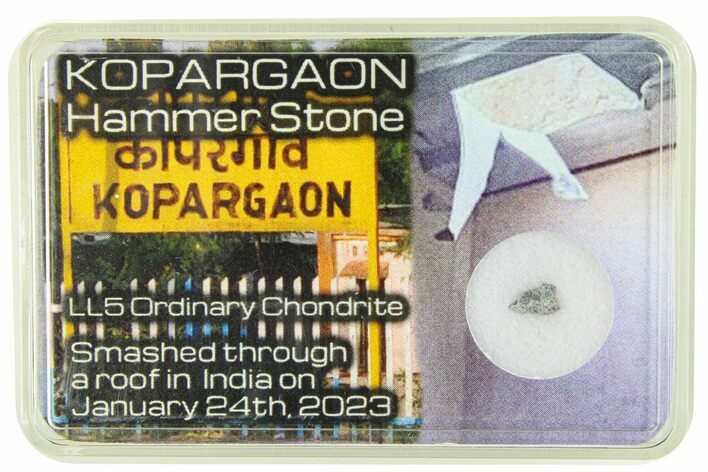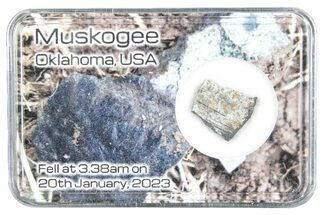.17" Chondrite Meteorite Hammer Stone (0.03 g) - Kopargaon
This is a hammer stone from the LL5 chondrite known as Kopargaon, which fell near the town of the same name in India on the morning of January 24, 2023. It comes in its own labeled display case.
This LL5 chondrite made quite a smashing entrance when it landed in the village of Bhojade Chouki, part of the Kopargaon administrative district in central Maharashtra, India. On January 24, 2023, at just about 7:00AM local time, several eyewitnesses reported sounds of detonations and bright objects falling from the sky. These objects were this chonridte, which smashed through the roof of a house in the village. It shattered on impact and left an impact dent in the bedroom it fell in: quite the wake-up call!
Kopargaon resembles many chondrites, containing brecciated clasts with occasional metal grains, brown limonitic oxidation stains, and chondrules in a light gray matrix. Several fragments retain a dark, dull fusion crust, regmaglypts, and even radiating flow lines as this molten material solidified. About a kilogram of material in total is known.
Kopargaon resembles many chondrites, containing brecciated clasts with occasional metal grains, brown limonitic oxidation stains, and chondrules in a light gray matrix. Several fragments retain a dark, dull fusion crust, regmaglypts, and even radiating flow lines as this molten material solidified. About a kilogram of material in total is known.
What Is A Hammer Stone?
Hammer stones are the names given to meteorite fragments that hit man-made objects, animals, or people when they fall. Hammer stones are often identified by the scuffed fusion crusts that can contain traces of paint, rubble, or other materials from the objects they hit. Because they are so rare, they are valued collectors' items. Often the items hammer stones hit go up in value, just be being damaged by a meteorite!
Hammer stones are the names given to meteorite fragments that hit man-made objects, animals, or people when they fall. Hammer stones are often identified by the scuffed fusion crusts that can contain traces of paint, rubble, or other materials from the objects they hit. Because they are so rare, they are valued collectors' items. Often the items hammer stones hit go up in value, just be being damaged by a meteorite!
What Is An L5 Chondrite?
An L5 chondrite is a type of stony meteorite that falls under the "L" (low iron) chondrite group. L chondrites have lower iron content (around 7-11% iron, mostly in the form of iron sulfide or silicates) and typically show less metal than H chondrites (high iron chondrites). They primarily consist of silicate minerals like olivine and pyroxene.
The "5" rating indicates a high degree of thermal metamorphism. This means that the L5 chondrite experienced substantial heating, likely on its parent asteroid, which caused partial recrystallization of minerals. As a result, the original chondrules (small, rounded particles) are less distinct and partially altered, though still visible. L5 chondrites usually have a light to medium gray matrix, and the chondrules tend to be less clearly defined due to metamorphic alteration. You may still see rounded chondrule outlines, but they appear partially integrated with the surrounding matrix.
The L chondrite group is believed to come from a specific parent body in the asteroid belt, which likely experienced a major collisional event. This event may have sent large quantities of L chondritic material into space, resulting in the abundance of L chondrites found on Earth.
An L5 chondrite is a type of stony meteorite that falls under the "L" (low iron) chondrite group. L chondrites have lower iron content (around 7-11% iron, mostly in the form of iron sulfide or silicates) and typically show less metal than H chondrites (high iron chondrites). They primarily consist of silicate minerals like olivine and pyroxene.
The "5" rating indicates a high degree of thermal metamorphism. This means that the L5 chondrite experienced substantial heating, likely on its parent asteroid, which caused partial recrystallization of minerals. As a result, the original chondrules (small, rounded particles) are less distinct and partially altered, though still visible. L5 chondrites usually have a light to medium gray matrix, and the chondrules tend to be less clearly defined due to metamorphic alteration. You may still see rounded chondrule outlines, but they appear partially integrated with the surrounding matrix.
The L chondrite group is believed to come from a specific parent body in the asteroid belt, which likely experienced a major collisional event. This event may have sent large quantities of L chondritic material into space, resulting in the abundance of L chondrites found on Earth.
$35
TYPE
Ordinary Chondrite (LL5)
LOCATION
Bhojade Chouki, Kopargaon taluka, Ahmednagar district, Maharashtra, India
SIZE
.17" wide, Weight: 0.03 grams
CATEGORY
ITEM
#286038
 Reviews
Reviews









